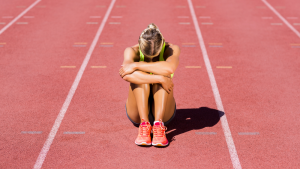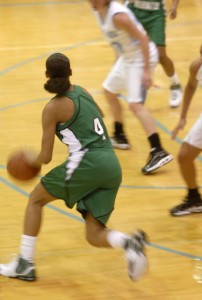Brian Schiff’s Blog
Injury Prevention, Sports Rehab & Performance Training Expert
Unfortunately, injuries cause more than pain and lost playing time for athletes. In many cases, an injury negatively impacts self-esteem and creates fear and anxiety. For competitive athletes, the injury often separates them from their familiar role and identity with respect to their teammates, coaches and peers.
It seems rather obvious that injured athletes would want to return to sport as soon as possible, right? Based on my clinical observations and experience, most athletes are motivated to return after their first injury. The more serious the injury (e.g. ACL tear, Achilles tendon rupture or UCL tear), the longer the road to get back. The speed and ease of the process is affected by the patient’s response to injury and surgery (coper vs. non-coper), degree of injury, skill of the surgeon, effectiveness of rehab, and patient compliance.
Much of the research done to date with fear of re-injury has centered on athletes undergoing ACL reconstruction. Over the last decade, methods for measuring kinesiophobia (fear of movement associated with sport/injury) such as the Tampa Scale of Kinesiophobia. I routinely use the TSK-11 with my athletes. In addition, the ACL-RSI is another tool for evaluating psychosocial readiness to return to sport. As sports medicine practitioners, we must pay attention to our clients’ fears and mental status.
Invariably, not all athletes want to return to sport. Factors that may hinder return to sport are:
- Chronic pain
- Fear of re-injury
- Fear or anxiety about long term pain, injury or future disability (such as osteoarthritis)
- Anxiety about not being able to return to their prior level of performance
I am currently working to attain my transitional doctorate in physical therapy (tDPT) at Northeastern University. As I continue to work full time as a clinician, it has been really cool to apply the learning with my current caseload. At this time, I am in a motor control class that is both fascinating and challenging. In week three, we examined pain and the impact it has on neuroplasticity (the brain’s ability to adapt or change).

In the sports medicine realm, I generally think many practitioners solely focus on the musculoskeletal system or physical impairment. As such, interventions are developed around tissue constraints, ROM deficits, weakness, etc. Too often, we look past the power and impact of the brain and how it plays a vital role in healing and return to play. For some patients, there is a maladaptive response to injury/surgery and a hypersensitivity of the central nervous system or central sensitization that occurs. Pelletier (2015) notes that structural and functional changes can occur. (1)
Two critical concepts to consider here are:
- Sensory amplification – sensory and motor representations change resulting in perceptual changes in body image, motor control changes, and even a persistence or amplification of pain
- Experience dependent plasticity – patient’s response to pain is related to prior experience and may experience maladatpive imprinting where the pain outlasts the physical insult
Kleim (2008) gives a great lesson on experience dependent plasticity and states that learning is essential for the brain to adapt to damage self taught behavioral changes can be maladaptive or positive and specific forms of neural plasticity and associated behavioral changes are dependent on specific kinds of experience (2). While one would assume that chronic pain is rare in athletes, I would counter and say it is probably just overlooked as we tend to expect athletes to “push through the pain” because of the driven culture we live in. Coaches, parents and even teammates can affect the mindset around injury and recovery.
Over the years, I have been fortunate to work with lots of athletes ranging from youth to professionals. Regardless of age or skill level, I have observed that each one approaches the recovery in their own way. Some are eager to tackle therapy, while others are apprehensive and fearful.

To be clear, the mindset of the patient is as important, if not more important than the physical part of the process as it relates to success. With ACL rehab, I pay close attention at post-op visit number one to determine if the patient is a coper, non-coper or somewhere in between. Having this awareness is crucial as I look to encourage the client and position him/her for success in the fist phase of rehab. The mindset of a patient recovering from their second or third ACL tear may differ greatly than that of a first timer.
With that said, assessing the state of mind of any athlete in the PT clinic is a must. An athlete’s identity, confidence and self-worth is often tied to his/her sport. Injuries separate the athletes from their teams and take away something very important to them. This can lead to depression, anxiety, anger, fear and loneliness to name a few.
It is imperative to connect with an athlete in the first 1-2 visits of rehab. I aim to bond with them and ensure they know I will do everything in my power to get them back to their prior level of performance. Fear of loss is powerful, and I want to partner with them to prevent the loss of playing time as quickly and safely I can though proper rehab.
Unfortunately, I see far too many patients following ACL reconstruction in my sports medicine practice. In any given month, I am rehabbing between 10 and 15 patients who have lost their season to this injury. Most of the time it is a non-contact mechanism of injury, often involving additional trauma to the collateral ligaments, menisci and/or cartilage within the joint.
Throughout my career, I have rehabbed several hundred athletes with ACL tears. It has always been an area of interest and passion for me as well as prevention. Blending my background in performance training with rehab, I have fostered through much trial and adjustment what seems to be a very effective approach to rehab and return to sport. Rehabbing higher level athletes is much like working on a high performance sports cars.
If you own a high performance vehicle, you would prefer to have it serviced at a dealership where the mechanics are experienced working on similar cars, yes? I feel the same care and application is relevant with ACL rehab. PT that is too aggressive or too conservative can impede progress and negatively impact peak performance.
As a sports medicine professional and physical therapist working with lots of athletes after ACL surgery, I am always looking for ways to improve post-op rehab and prevent a subsequent ACL injury. While we have lots of research looking at neuromuscular, genetic, sex and morphologic risk factors, we have not been able to make significant progress in injury reduction. So many athletes suffer the dreaded “pop” making a simple athletic maneuver they have done a thousand times before.
Based on nearly 19 years of experience training and rehabbing athletes from youth to professionals, I see strong links to a genetic predisposition (family history and prior injury) as well as concerns over neural fatigue. We already know the age of injury is a significant as research indicates those tearing at a younger age (around 20-21 y/o) are more likely to suffer a second injury. But what we know less about is the impact of ankle biomechanics (namely limited dorsiflexion) and how proximal weakness in the hip affects injury risk.
The latter topic was the focus of a study just published in the current edition of the American Journal of Sports Medicine. In this prospective study, researchers sought to determine if baseline hip strength can predict future non-contact ACL tears in athletes.



